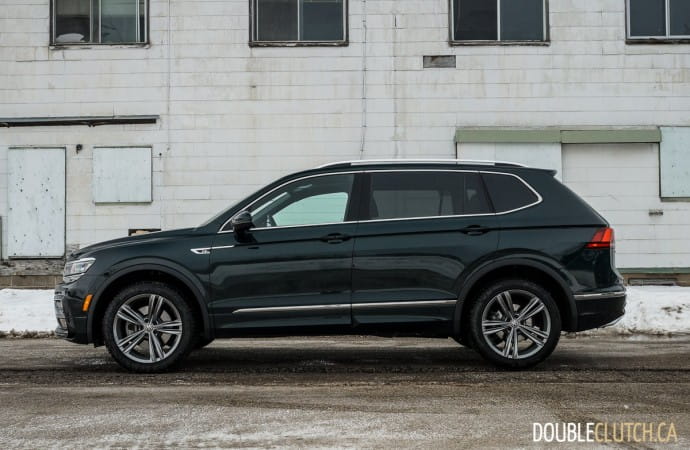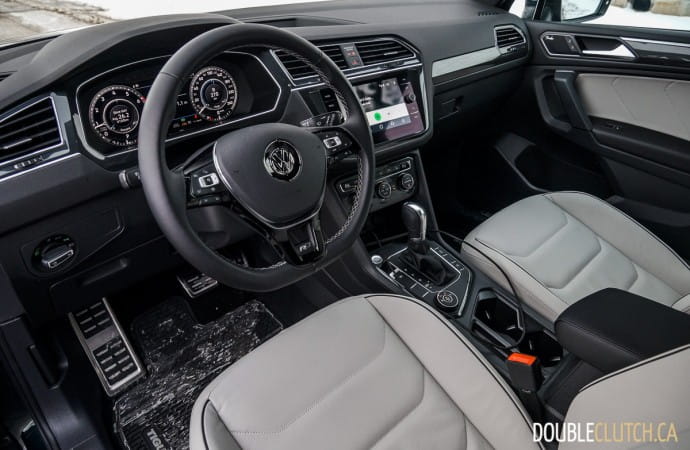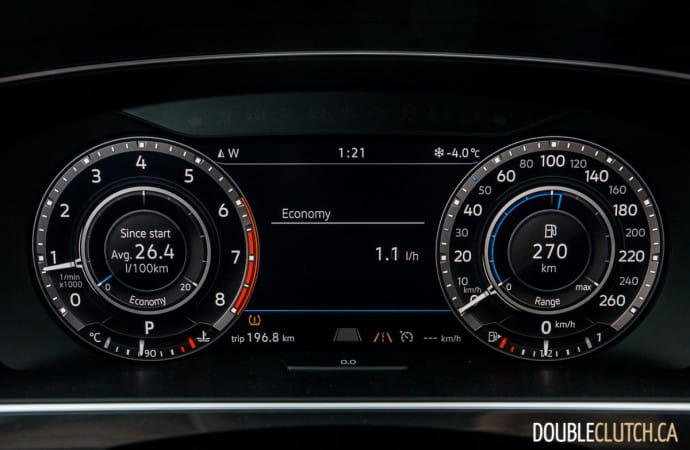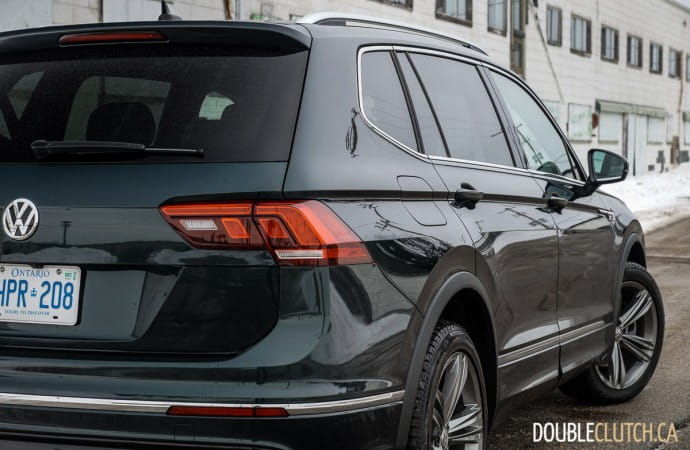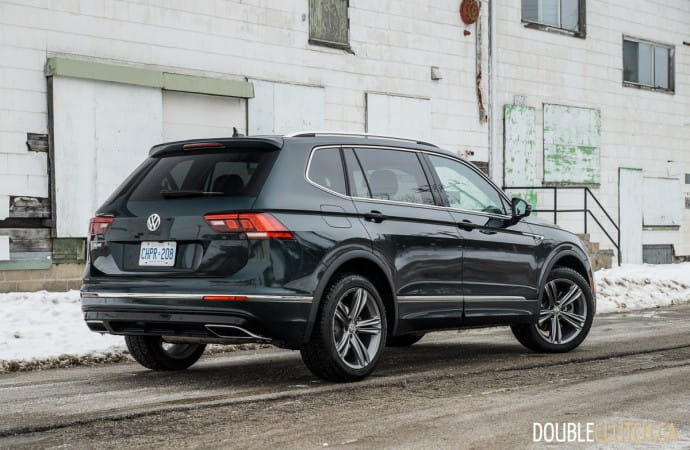When it first came out for the 2007 model year, the Volkswagen Tiguan was starting to ride the wave of compact crossover sport utility vehicles that would end up taking the industry by storm. Unfortunately, VW let that generation fester for a little longer than it should have, making it stretch all the way to 2017. In its second year of production, the 2019 Volkswagen Tiguan Highline is now built on the MQB (Modularer Querbaukasten) platform, which underpins everything from the compact Golf (reviewed here) to the three-row crossover Atlas. Volkswagen Canada recently sent over a Dark Moss Green Metallic top of the range example for a week of testing, and the DoubleClutch.ca Magazine editorial team got to see what it was all about.
While the base front-drive Tiguan starts at $29,225, the Highline is on the opposite end of the spectrum at $39,575. At this price point, drivers get remote start, a park distance control system, Fender premium audio, eight-inch touch screen infotainment with navigation, LED headlights with an adaptive front-light system (swivel with steering), power liftgate, silver roof rails, 18-inch alloy wheels, heated steering wheel, Vienna leather seats, and a power adjustable driver’s seat with memory function.
Options on the test car included the $750 third row package (two extra passengers), the $1,295 Driver Assistance Package (adaptive cruise with stop and go, lane keep assist, automatic high beams, and a 360-degree camera), and the $1,960 R-Line package. The bottom line came to $43,580, which is a relative pretty penny in this segment. Amongst the Tiguan’s competitors are the Toyota RAV4, Honda CR-V, Subaru Forester, Mazda CX-5, Chevrolet Equinox, Kia Sportage, and Ford Escape.
For most people, the practicality of a crossover sport utility is what draws them into buying one. The Tiguan is good for 1,065L (37.6 cubic feet) of cargo space with the second row of seating up (and the third row down), and grows to 2,081L (73.5 cubic feet) with the second and third rows folded down. This is pretty good, but do be aware that cargo volume measurement standards only apply up to the top of the seatbacks. Larger, more awkward cargo may vary.
Having the $750 third row is one advantage of the Tiguan, and allows for a total of seven passengers on board. Leg, hip, and head room is certainly at a premium at the very back, but given the size and class of vehicle, it’s no surprise that the third row should only be used for smaller or more disliked passengers. First and second row comfort is much better, and the VW is most ideally suited to up to four people and all their stuff. The second row is adjustable for both fore and aft and also recline, and the outboard positions have seat bottoms that are long enough to provide sufficient thigh support.
As practical as the Tiguan is for space and seating, it’s also quite good for technology and connectivity. Volkswagen’s eight-inch AppConnect touch screen interface is easy to work with and has a high resolution screen, although the current implementation of the system (on or around 2018 and beyond) makes the use of touch-based buttons flanking the screen. Hard buttons may not look as clean, but are far superior for reducing driver distraction. Android Auto and Apple CarPlay are standard equipment, and make smartphone pairing extra simple with a clean, consistent interface that matches your current smartphone.
Interior quality is good, with above average attention to detail and solid fit and finish. The Highline’s Volkswagen Digital Cockpit is a full screen for the instrument cluster, and while the resolution and clarity are excellent, the layout is a bit busy and the speedometer can be hard to read. It is configurable in many ways thankfully, and a larger digital speed readout is basically a must-do in order to see how fast you’re going.
Powering all trim levels of the 2019 Tiguan is a 2.0L turbocharged four cylinder engine. Peak output is 184 horsepower at 4,400RPM, paired with a healthy 221 lb-ft of torque at 1,600RPM. Built from the same EA888 engine family as all other current VW turbo fours, it is oddly not as good as implementations in other smaller cars such as the Golf and Jetta, who get the EA888 in 1.8-litre form, or the EA211 that displaces 1.4-litres. In the Tiguan, the engine is gruff and rough sounding, and in fact feels way too much like the outdated previous generation engine in terms of refinement and power delivery. Vibration was particularly noticeable at idle in cold weather, regardless of whether the engine was fully warmed up.
Paired to the turbo four is an eight-speed automatic transmission. Unfortunately, unlike the other cars in VW’s lineup, it also doesn’t do the Tiguan any favours. Instead of making use of the turbo and shifting at a relatively low RPM, the Tiguan likes to wind out past 3,000RPM when launching from a stop, even when not pushing very hard or when not using the transmission’s Sport mode. This made things feel a lot more laboured than they needed to be, and also contributed to the extra noise, vibration, and harshness (NVH) of the powertrain. The gear ratios were also a little oddly spaced, with the first three being too tall, hampering acceleration.
The gearing calibration may have been in order to address fuel consumption figures, which are nominally rated at 10.7L/100KM in the city, and 8.0L/100KM on the highway. Observed economy with mixed driving in a series of significant snow storms netted 11.3L/100KM. Fuel tank capacity is 60 litres, and unlike the turbo four cylinder engines of years past, regular 87 octane (AKI) fuel is completely acceptable.
On the road, the VW does relatively well in terms of road feel and handling while maintaining good ride quality that’s a bit on the firmer side, as is typical for many European cars. The steering and powertrain are adjustable in a series of normal and sportier modes, and snow and off-road drive mode settings are also available. The R-Line package ups the wheels to 19-inch units with 255/45 R19 tires, and the extra width didn’t seem to cause the snowshoe effect when driving in deep snow, which would normally cause poor traction. At highway speeds, the cabin is a quiet place to spend time, and it’s clear that Volkswagen has invested heavily in this area over the last few years.
Overall, the 2019 Volkswagen Tiguan Highline is a good enough effort by Volkswagen, who has a loyal following of buyers who are looking for a little bit more flair anything that they buy. The Tiguan delivers reasonably well in this regard, but the unrefined powertrain holds it back against the competition. A four-year, 80,000KM warranty is a one-year, 20,000KM advantage over others, which may be enough to push it over the edge for some. The sticker price of the Highline as-equipped is also a couple thousand higher than similar heavy hitters such as the Toyota RAV4 Limited and Subaru Forester Premier, which are both more preferable in this class other than the lack of an emergency-only third row of seating. This is a difficult class to compete in, and Volkswagen will need a few updates in a mid-cycle refresh in order to catch up with the Joneses.



